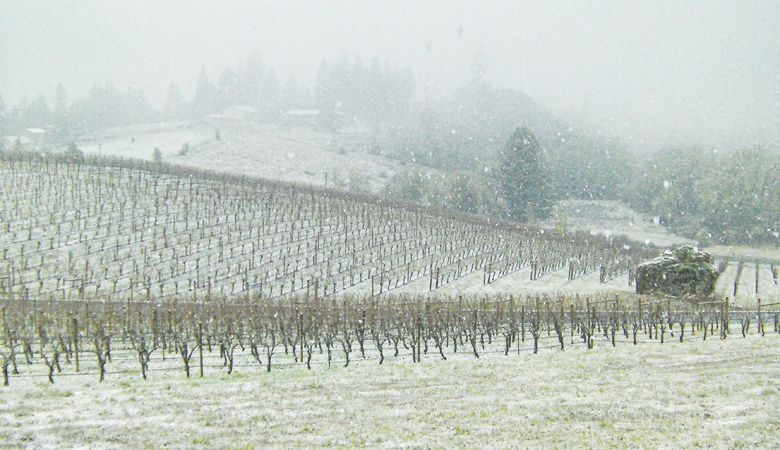Winter Slumber
The Importance of Winter to Viticulture and Wine Production

By DR. GREG JONES
The wines from the last vintage are snug in their barrels or tanks with some nearing bottling. But what’s going on in the vineyard? The winter or dormant period in a vineyard is quite busy with pruning, vineyard repairs and other activities, all in preparation for the coming vintage.
Similar to the growing season, growers watch the weather for wintertime risks; which guides the work necessary before spring.
Grapevines go through three stages during the winter. Each region’s climate and weather dictate when and how they happen, along with any associated risk. The first is acclimation or the transition from a cold-tender to cold-hardy state. This readies the vines for the second stage, maximum cold hardiness, occurring in the middle of winter. The final stage, deacclimation, takes place in late winter– as the plants return to a cold tender state.
Acclimation begins when grapevines drop their leaves following the first fall or winter cold snap. Growers prefer a slow transition into acclimation rather than an abrupt shift to colder conditions. Horticultural crops do best when they experience a gradual cooling, often referred to as hardening off. While many perennial plants, including grapevines, fruit and nut trees, require exposure to cold temperatures during the winter, most have cold tolerant limits.
Extreme cold temperatures during the winter can be detrimental to grapevines, depends on the type. Vitis vinifera cultivars, the main wine-producing grapes from Eurasia, are generally the most sensitive to cold winter temperature extremes with damage occurring when temperatures dip down to 5°F to -15°F. French-American hybrids are generally hardier; for example, Chambourcin and Baco Noir can survive lows of -20°F or so. Native cultivars, such as Concord and Muscadine are often the toughest and able to endure cold weather down to -30°F or so.
In our region, extreme cold winter conditions most often happen in the inland Pacific Northwest, where colder continental air can reach temperatures that may damage wine grape cultivars. Typically, Oregon’s western valleys don’t experience harmful winter temperatures, but if acclimation does not take place prior to moderately cold conditions, grapevines in these regions be damaged.
Another consideration is the amount of time each vine spends at low temperatures. During the winter, grapevines need a certain amount of cold to experience normal spring growth. While most horticultural crops have ‘chilling requirements,’ grapevines don’t need as much as other plants. However, they still require sufficient chilling. Without it, they are likely to see delayed or irregular budbreak, lower numbers of shoots and clusters, and often poor fruit development and possibly compromised quality.
The process of deacclimation occurs after the coldest period of the winter and readies the grapevine to resume growth and development in the spring.
As you read this, grapevines are undergoing the maximum cold hardiness stage with pruning likely in full force around the state. Soon the plants will enter deacclimate; as the days get longer, the soil warms and spring nears.
Year after year, Oregon’s climate contributes to our celebrated vintage variation. WEATHER, CLIMATE AND WINE explains how the weather affects our grapevines, fruit and, ultimately, wines. Visit www.climateofwine.com to read more in-depth reports.









